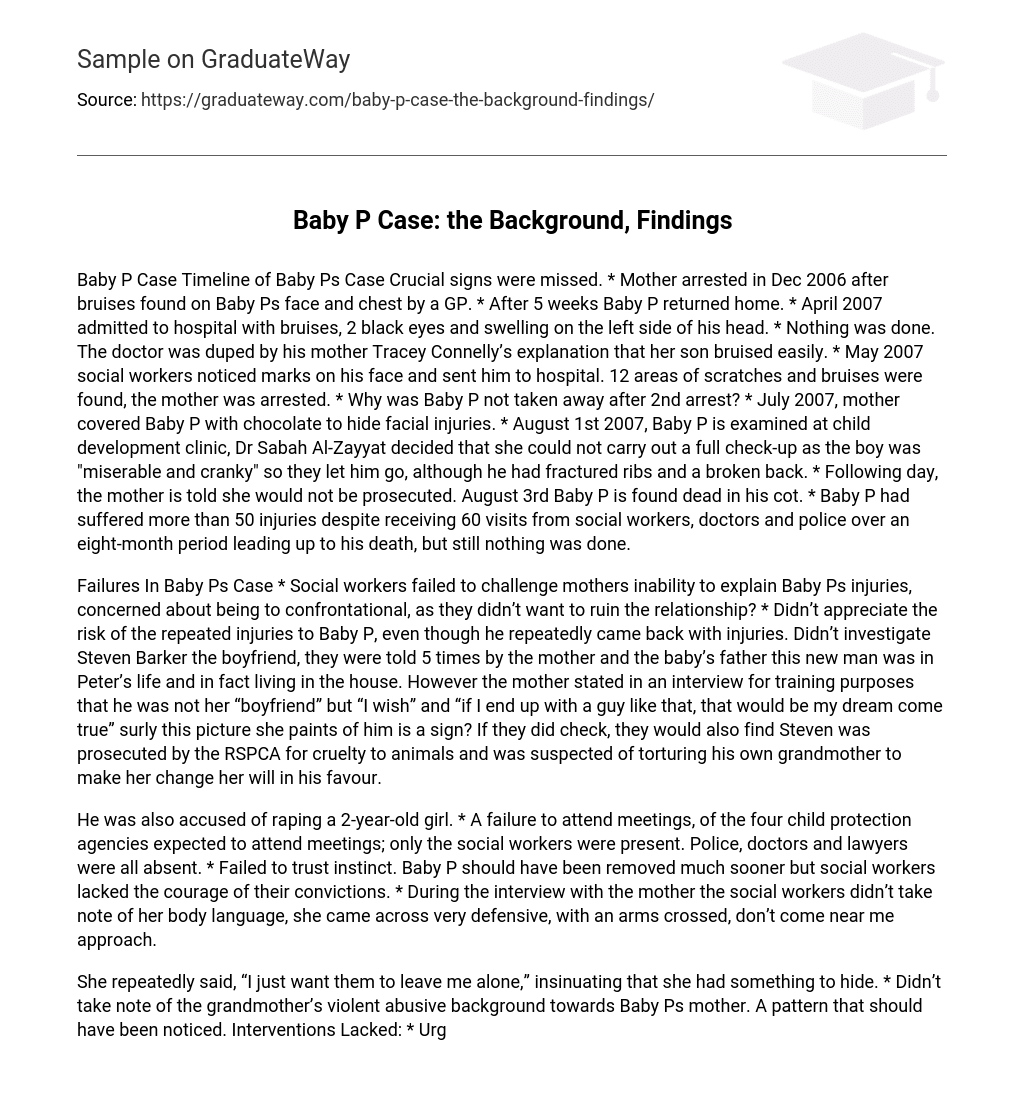Crucial signs were missed
- Mother arrested in Dec 2006 after bruises found on Baby Ps face and chest by a GP.
- After 5 weeks Baby P returned home.
- April 2007 admitted to hospital with bruises, 2 black eyes and swelling on the left side of his head.
- Nothing was done. The doctor was duped by his mother Tracey Connelly’s explanation that her son bruised easily.
- May 2007 social workers noticed marks on his face and sent him to hospital. 12 areas of scratches and bruises were found, the mother was arrested.
- July 2007, mother covered Baby P with chocolate to hide facial injuries.
- August 1st 2007, Baby P is examined at child development clinic, Dr Sabah Al-Zayyat decided that she could not carry out a full check-up as the boy was “miserable and cranky” so they let him go, although he had fractured ribs and a broken back. *
- Following day, the mother is told she would not be prosecuted. August 3rd Baby P is found dead in his cot.
- Baby P had suffered more than 50 injuries despite receiving 60 visits from social workers, doctors and police over an eight-month period leading up to his death, but still nothing was done.
Failures In Baby Ps Case
Social workers failed to challenge mothers inability to explain Baby Ps injuries, concerned about being to confrontational, as they didn’t want to ruin the relationship? Didn’t appreciate the risk of the repeated injuries to Baby P, even though he repeatedly came back with injuries. Didn’t investigate Steven Barker the boyfriend, they were told 5 times by the mother and the baby’s father this new man was in Peter’s life and in fact living in the house.
However the mother stated in an interview for training purposes that he was not her “boyfriend” but “I wish” and “if I end up with a guy like that, that would be my dream come true” surly this picture she paints of him is a sign? If they did check, they would also find Steven was prosecuted by the RSPCA for cruelty to animals and was suspected of torturing his own grandmother to make her change her will in his favour. He was also accused of raping a 2-year-old girl.
A failure to attend meetings, of the four child protection agencies expected to attend meetings; only the social workers were present. Police, doctors and lawyers were all absent. Failed to trust instinct. Baby P should have been removed much sooner but social workers lacked the courage of their convictions.
During the interview with the mother the social workers didn’t take note of her body language, she came across very defensive, with an arms crossed, don’t come near me approach. She repeatedly said, “I just want them to leave me alone,” insinuating that she had something to hide. Didn’t take note of the grandmother’s violent abusive background towards Baby Ps mother. A pattern that should have been noticed.
Conclusion
Clearly there is more that needs to be tackled in order to provide an effective role within the multi-agency teams working in the early year’s settings. Our findings show that there is a slight divide when it comes to ‘joined up thinking’, with a lot of assumptions that other teams will do the work, leading to important information being missed. Therefore different agencies may not appreciate each other’s roles. There has been a considerable increase in children that have been taking into care since late 2008 after the infamous Baby P case.
Thus indicating the new reform to the Laming report due to the vital failures that lead to Baby P’s horrific death, show there are signs of improvement for children’s safety. We believe by taking a note of the Triple P program, this could enhance the performance of social workers and multi agencies. In our opinion they need to communicate more efficiently, perhaps using a more enhanced computer system. For example if the child goes into a hospital with suspicious bruises, it can be entered into the system for all agencies to see, so that when the name of the child comes up again, any previous incidents will be seen.





